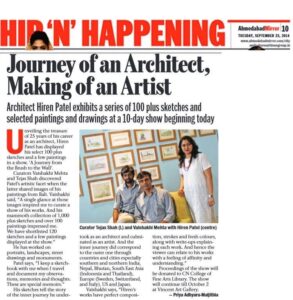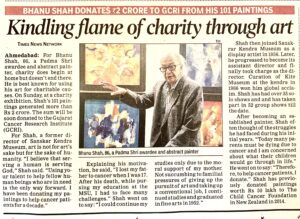A place strictly designated for grim litigation – Gujarat High Court was abuzz with art lovers visiting two-day Art Exhibition held at the court premises to display the art works of the advocates. Priya Adhyaru-Majithia took a stroll at the exhibition and presents the glimpses for the show.
In an attempt to transcend the mundane boundaries of black and white, advocates from city have turned towards artistic pursuits and their amazing art work are on an exhibit held at the ladies bar room at Gujarat High Court. The two-day exhibition organised by Gujarat High Court Advocates’ Association (GHAA) was inaugurated by the chief justice and justice Bhaskar Bhattacharya on Thursday.
About 100 artworks including paintings, poems, craftworks, photographs, mud artefacts and fabric paintings are put on display by 24 advocate-turned-artists at the exhibition. Initiator and convener of the show, Megha Chitalia, assistant government pleader, said, “We promote pursuit of art in any form. Artistic creation is a major force that helps many of us to refresh ourselves. And by holding an exhibition of art works of the advocates, we encourage them to purse art at deeper level. The first exhibition of GHAA took place in 2011.”
Aesthetic corners
Megha Chitalia
Ganesha playing musical notes in an open pasture – an artwork of mud and clay statues of Ganesha fixed on wood painting, a small hut of village of Kutch which is called bhugna (rural home made of donkey dung and clay) – more than 20 artworks displayed at the show caught attention of the every visitor who glanced through the show. Many eyes kept turning towards paintings and artefacts by Megha Chitalia, the initiator of the exhibition. Her artworks included paintings on theme of deserts, rural women, horses and more. Her mature strokes and symmetrical creations enhanced the outlook of the entire display.
K S Jani, advocate and participant
“And the words come gushing to me,” said K S Jani, a senior advocate who has displayed his poetry written on the day-today life incidents, emotions and moods. He has penned down more than 40 poems of which a few were a part of the display. Jani writes poems in Gujarati, Hindi, and English. Using trivial metaphors and easy symbols he expresses newer visions and meanings of life. “The process of creation refreshes me and adds zeal to my existence,” said Jani.
Nilkanth Trivedi, co-convener of the show
Young environment lawyer and adventurous photo artist Trivedi displayed a wide collection of photographs taken during span of a decade. Trivedi has done extensive marine photography in and around areas of Jamnagar, Dwarka over the series of 20 islands spread in that region. Trivedi who has been taking photos of live corals, rare species of sea creatures, female and male seagulls, cob webs – attempts to capture the aesthetics of marine life and surroundings. “This is my first love. My rendezvous with underwater photography began in 2003. I capture the scenic beauty of unexplored regions under the sea as I want to sensitize the viewers to protect these regions and save them from pollution,” said Trivedi. He has displayed his photographs at four exhibitions in city and Mumbai.
Divyesh Sejpal
His art work consisted of a large collections of photographs divided into five sections landscapes, nature and man, children, flora and fauna and micro-life. His collection was one of the main components at the exhibition that set the ambiance of the show. His extensive photography defined him as a magnificent artist who captured the right elements and its rarest moments. “Pursuing art and letting the creative side grow within us, makes us strong enough to face the grimmest and bleakest side of human nature that we witness every day in courtrooms,” said Nimisha Prakash whose poems were displayed next to Sejpal’s art works. Nimisha’s poems are centred on the theme of divinity. “Writing poems is the best de-stressing technique that works for me,” she added.
Peripheral attractions
The entry corner of the GHAA exhibition opened with sketches by Asit Mehta and progressed to display caricatures by Ramchandra Modi. Modi’s satirical caricatures ridiculed the grim and tall social notions and political perceptions.
Modi’s artworks were juxtaposed by poems by Nimisha Prakash whose serene tone conveyed a firm faith in the soul of the universe. The note of faith continued through the paintings depicting various forms of God by Renu Chaudhary who believes pursuing art makes one a better human being and enriches one from within.
The section of live photography began with photographs of tiger, peacock, humming bird and other rare poses of wild creatures captured by additional public prosecutor Krina Calla. The photos were again juxtaposed by Niyati Jhuthani’s emotive poems and Jaishree Kadiya’s paintings.
Amid the series of artworks including Vyoma Jhaveri’s craftworks, Nirav Trivedi’s poetry, Nita Merchant’s paintings of variety of moods and emotions, a major component of the entire display was seen in live photo projection of Divyesh Sejpal and Nilkanth Trivedi’s photo art.
The exhibition also included poetry by Vasantsingh Giri, photographs of Vaishnodevi, Kashmir, Jem Corbett, Dalhousie and more places by Ashlesha Patel. The corner displaying photographs by Aditya Mehta which showcases hues of Rajasthan, North Sikkim, Aamby valley city of Maharashtra had eye catching elements.
Ganesha made using sacred red thread (nadachhadi) by Neha Shukla was one of the gorgeous art pieces exhibited at the show. Kishore Prajapati’s crafts and Tejal Shah’s photographs containing scenes of Rajasthan and Hydrabad added to the impressive outlook of the exhibition.
Meha Chitalia’s artwork including craft works and paintings occupied a large section at the show and was one of the few corners frequented by every visitor. Next on the display were Jani’s poems, sari fabric paintings by Kalpana Brahmbhatt, Nisha Parikh’s knitted outfits and craft artifects by Varsha Brahmbhatt. The entire exhibition aptly revealed the colourful side of the advocates who are professionally forced to remain trapped between grave black and white boundaries in their routine life.

